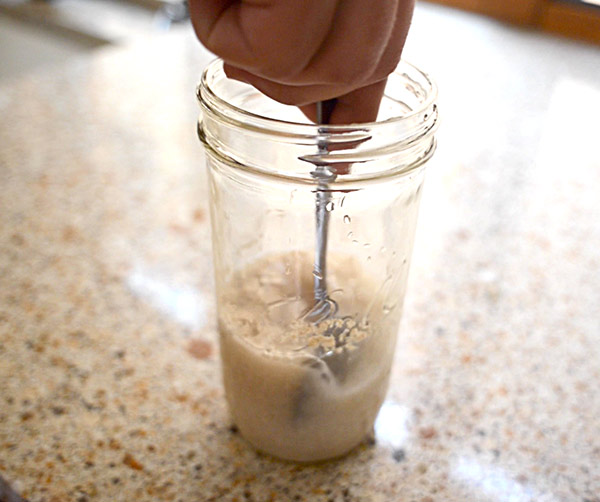
The concept is simple: if yeast doesn’t provide the necessary tools and environment to conduct a healthy fermentation, the final mead or beer can be riddled with flaws.
In order to combat this problem, mead nutrient additions can be added to yeast during fermentation that will make for a fast, robust fermentation and lessen the chances of developing off-flavors.
Why are Nutrients Important?
After yeast is pitched into mead must, it prepares for a period of growth followed by fermentation. Growth refers both to an individual cell and the overall cell population. It is particularly crucial for individual yeast cells to have the proper nutrients available to revitalize cell membranes in order to prepare them for the work ahead.
The presence of nutrients throughout the entire fermentation process is important, even after growth has concluded. If yeast aren’t kept healthy throughout fermentation, then the state of the yeast deteriorates and could cause fermentation to cease prematurely. When this happens, flaws and off-flavors in the final mead occur.
The trouble is that the simple mixture of honey and water is lacking nearly all the essential micronutrients for yeast to flourish. Even when additional ingredients like fruit or a small amount of malt are utilized in a mead recipe, nutrient levels are still generally insufficient to the yeast’s needs.
Nitrogen & Other Micronutrients
There are a wide array of vitamins, minerals and other nutrients that yeast constantly need in order to stay healthy, grow and metabolize sugars. Without these nutrients, meadmakers run the risk of failed fermentations, under attenuation and off-flavors. Researchers have determined optimal amounts for various chemicals, which you can learn more about in Ken Schramm’s article “Optimizing Honey Fermentation.”
Nitrogen is particularly important throughout the fermentation process, and worth mentioning specifically. It is utilized in the growth stage while the yeast is fortifying its cell membranes, and during the metabolic stage when yeast is converting sugars into alcohol and CO2. Without appropriate levels of nitrogen, fermentation can be prolonged and incomplete.
While nitrogen levels in honey vary from one varietal to the next, it is rare to see more than 150 mg/L of nitrogen in honey, with levels often times coming in much below that. It is said that yeast need nitrogen levels in the range of 300-500 mg/l for quality fermentation, which must be supplemented through nutrient additions.
Energizers, Nutrients and Blends
The list of nutrients desired by yeast during mead fermentation is rather lengthy, but homebrew suppliers and shops have made it relatively easy to provide yeast with the essentials by offering pre-made blends.
First, if using dry yeast, it is highly recommended to include some sort of nutritional rehydration agent. Dry yeast membranes are typically lacking many of the nutrients needed for fermentation, especially if when pitched into a high-gravity mead must, so it is a good idea to give them some of the essentials right off the bat. Products like Go-Ferm will give the yeast a nice boost during the rehydration process.
Once pitched into the must, the yeast gets right to work on growing before metabolizing sugars, and as mentioned above, nitrogen is extremely important in both these processes. Nitrogen can be purchased in the form of diammonium phosphate (DAP), which not only provides the nitrogen, but also phosphorus that the yeast utilizes.
The miscellaneous nutrients that can be added in addition to nitrogen are typically labeled as “yeast nutrient blends” or “yeast energizer blends.” Fermaid-K is an example of one of these blends. It is important to note that the terms “nutrient” and “energizer” are often used interchangeably in the industry, so be sure to pay close attention to what comprises the blend before purchasing. Using too much of one component, or nutrient can cause its own detectable off-flavor. It is also always recommended to follow the manufacturer’s instructions.
Staggered Nutrient Additions
Some recipes will call for all the nutrients to be added at the time when the yeast is first pitched into the must. This will undoubtedly provide the yeast with the essentials from the get-go, but the key to keeping yeast happy is providing them with all the desired nutrients throughout the entirety of the fermentation process. If adding all the nutrients at the beginning, it is very likely that a lot of the nutrients won’t even be utilized before flocculating out. For this reason, it is suggested to stagger the additions of nutrients during fermentation.
The technique of providing nutrients in increments is popularly known as staggered nutrient additions (SNA). The process consists of nutrient doses with periods of off-gassing in between.
Generally speaking, to put together an SNA schedule, determine the total amount of nutrients you want to provide the yeast and then divide it up into multiple additions. Some meadmakers do multiple equal additions every other day, while others add gradually smaller amounts at various intervals depending on the progress of the fermentation. It will all depend on what you prefer.
Here is an example staggered nutrient addition schedule that can be used for your standard 5-gallon batch of mead:
- Day 0: After re-hdyrating the yeast with Go-Ferm and pitching, add 4.5g of Fermaid-K and 2g Diammonium Phosphate (DAP)
- Day 1, 3, 5, 7, 8: Degas mead by gently stirring, twirling the carboy carefully, or using a wine de-gasser
- Day 2, 4, 6: Gently stir and add 4.5g Fermaid-K and 2g of DAP
- NOTE: When degassing and/or adding nutrients, do so very slowly to avoid foaming.
Visit our Let’s Brew section for mead making tutorials, mead recipes and tips on making better mead.
Sources: The Compleat Meadmaker by Ken Schramm; “Optimizing Honey Fermentation” by Ken Schramm (November/December 2005 Zymurgy); Yeast: The Practical Guide to Fermentation by Chris White and Jamil Zainasheff.





Share Post